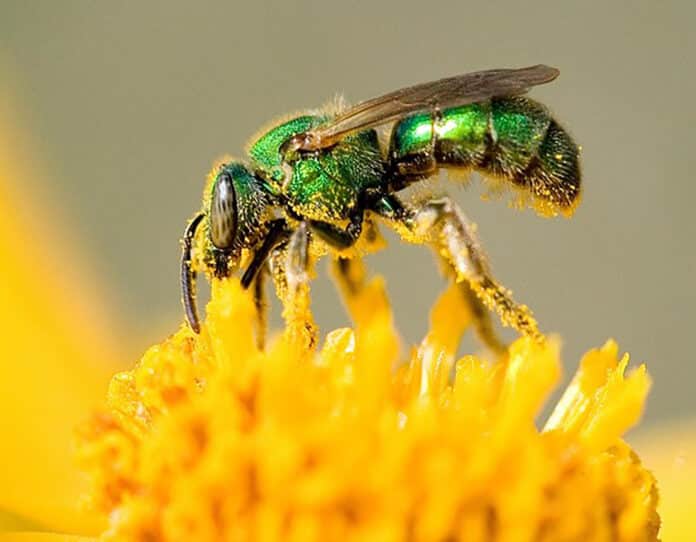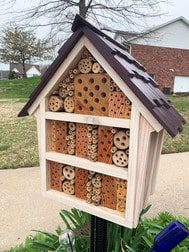
JEFFERSON CITY, Mo. – Spring and summer months bring both the buzz of lawnmowers and bees. These fuzzy flyers are important pollinators, playing a crucial role in the production of many favorite fruits and vegetables. The Missouri Department of Conservation (MDC) encourages the public to “bee-friend” these valuable native pollinators.
“Missouri is home to around 450 species of native bees, but it’s not uncommon for more to be identified each year,” said MDC Urban Wildlife Biologist Erin Shank. “There are several common bees Missourians will encounter, including the bumblebee, carpenter bees, sweat bees, and the leafcutter bee.”
Most native bees only live about one year. They emerge in the spring as adults, visiting flowers and buildings nests. Many species, such as bumblebees, make their nests underground, while others, such as leafcutter and mason bees, will set up shop in small cavities found in wood or in the pith of plant stems.
Bees may send some running for the hills for fear of being stung, but most native bees are harmless.
“Most don’t have stingers long enough to penetrate human skin,” said MDC Community and Private Land Conservation Branch Chief Bill White. White and his team work to create and maintain native wildlife habitat in communities and on private lands.
Additionally, native bees are doing their agricultural duty by pollinating flowering plants that provide food, fiber, and even medicines.
Shank explained that native bees, such as the bumblebee, are effective pollinators because of a technique called buzz pollination.
“It’s a vibrating movement involving their wing muscles that allows the bumblebee to free pollen from the anther, the flower’s pollen-producing structure,” Shank said. “This strategy causes the flower to explosively release pollen. There are some flowering plants that will release pollen only through buzz pollination. One favorite, the tomato plant, requires either buzz pollination or visitation by a larger bodied bee, such as the bumblebee.”
BEE A FRIEND
There are several ways the public can support Missouri’s native bees. Shank said the best way is to get floral.
“It’s all about the flowers,” Shank stressed. “Provide native companion plants, and especially those with colorful blossoms, because color attracts bees.”
Companion planting, in which one plant helps the growth of another, can help facilitate the pollination of fruits and vegetables. For example, planting bee balm can help pollinate tomatoes, peppers, and eggplant. Other examples of flowering companion plants include sunflowers, wild hyacinth, blue wild indigo, purple prairie clover, and common milkweed.
There are several options of flowering trees and shrubs, too.
“Redbud, American plum, and golden currant are great for pollinators,” said White.
Shank noted that providing more flowers can also mean not mowing the lawn as much.
“Clover, violets, and dandelions are some common lawn plants that provide vital food for bees – especially in the spring before most flowers appear,” Shank explained. “Delaying mowing or mowing higher can help bees by letting the plants grow. Even allowing access to the ground by not mulching every inch can help. Some bees need access to the soil to excavate their nests.”
NO YARD? NO PROBLEM!
Shank said residents who live in urban areas without access to a yard can still be a big help to native bees.
Surprisingly, St. Louis has one of the most diverse bee populations in the Midwest, with more than 200 species found in the city limits alone.
“You can offer bees native flowers in a planting box or pot,” Shank explained. “Getting involved in a community garden or helping plant at a nearby park is great, too.”

For those without a green thumb, it may be tempting to buy the bee houses or hotels being offered in stores. However, the real need is not nesting sites, but native flowering plants. Many of the commercially available bee hotels contain the wrong length of tubes or wrong diameter for Missouri’s bees. Find out how to build your own at https://www.xerces.org/publications/fact-sheets/nests-for-native-bees.
White stressed the need for yearly maintenance on bee houses.
“After bees emerge in the spring, either the used tubes need to be removed or plugged so they can’t be reused,” White stressed. “The tubes will harbor parasites and disease, as well as pollen mites that could impact another generation of bees wanting to use the house. The more houses erected in one spot, the bigger the problem becomes and more harm to local bees. The fact remains that native bees will benefit more from native flowering plants than bee houses. ”
UN-BEE-LIEVABLE
Bee pollinators’ national value is around $30 billion annually, and they are responsible for 1 in 3 bites of food Americans eat. Without bees and other pollinators, humans would not have foods such as grapes, nuts, coffee, and even chocolate.
“It’s easy to forget their critical role in agricultural food production,” Shank said. “But by making small strides to plant native flowers and shrubs, Missourians can support bee health and habitat.”
For more information on native companion plants, contact the Missouri Prairie Foundation’s Grow Native! program at moprairie.org/grownative
To learn more about Missouri’s native bee species, visit MDC’s online Field Guide at https://bit.ly/2Iq5OBw














